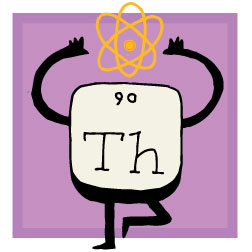Blogging the Periodic Table

Techno-utopians in the 1950s would have bet a lot of money that uranium and plutonium would have emerged as the most precious substances on the periodic table by now. Those elements seemed the only ones potent enough to replace oil and coal and meet our voracious appetite for energy. Indeed, they promised, in the catch phrase of the day, power "too cheap to meter."
Things didn't work out that way. Our government diverted most plutonium into nuclear weapons during the Cold War, and however cheap uranium power was per kilowatt-hour, it still had to be generated in horrendously expensive plants. Throw in Three Mile Island, and Americans had collectively given up on nuclear power by 1979—no new plants have been approved or started since. *
But these days carbon dioxide is a dirtier term than carbon rod (the controlling rods in current nuclear power plants), and power companies like Duke Energy have been toying with opening new nuclear plants for a few years now. Even some environmentalists with impressive credentials—Patrick Moore, James Lovelock, Stewart Brand—are willing to give nuclear power a chance. But this time around, the star element might not be uranium or plutonium, but one just a few boxes away on the periodic table, thorium.
Thorium gives scientists the chance to build a different and potentially safer kind of reactor. Normal reactors produce energy when (and I'm glossing over details here, of course) uranium atoms split into two lighter elements, like barium or lanthanum. Crucially, this split also produces neutrons. The neutrons fly away, smack into other uranium atoms, and cause them to split in turn—producing more neutrons. When this happens repeatedly, you have a chain reaction. Eventually, though, the store of uranium atoms decreases, and because conventional reactors use uranium so inefficiently, they die relatively quickly from lack of fuel and need constant replenishment.
By contrast, thorium "breeder reactors" actually make their own fuel, through a clever arrangement of radioactive elements. The reactor's initial source of power is again uranium. But it's a special kind of uranium, uranium-233 (which has 233 neutrons plus protons). And in this case the uranium is surrounded with jackets of thorium-232.
After a uranium atom fissions, a thorium atom absorbs a neutron and becomes thorium-233. Like uranium, this thorium is unstable and undergoes radioactive decay. But it undergoes a different type of decay than nuclear fission. It undergoes beta decay, where the nucleus spits out an electron.
Now, an atom cannot just create an electron (charge = -1) without compensating that charge somewhere else. Charges have to balance out to zero, so the atom also converts a neutron into a positive proton (charge = +1). Atoms are defined by how many protons they have, so the addition of a proton shifts the atom to a new spot on the periodic table. It becomes protactinium-233.
Protactinium-233, also unstable, soon spits out another electron and transforms into ... what you started with, uranium-233. Almost magically, then, you get more fuel just by combining elements that go radioactive in the right way. Because they make their own fuel, breeder reactors also require less maintenance. What's more, they produce less nuclear waste.
Breeder reactors seem so efficient and enticing that they're perfect for utopian fantasies. And in fact, a breeder reactor was at the heart of one of the most quixotic crimes in American history—when an Eagle Scout tried to build a breeder reactor in his mom's potting shed in the backyard of their Detroit-area home in the mid-1990s. He said he was trying to save the world.
Dubbed the Radioactive Boy Scout, the teenager obtained his thorium from special flashlights called miner's lanterns, which use thorium as an incandescent filament. (Thorium glows brighter than most metals when heated.) He even built a crude "neutron gun" to irradiate his thorium and get the chain reaction going. Perhaps fortunately, the Eagle Scout didn't understand chemistry very well and managed to irradiate only the contents of the potting shed (including himself). When law enforcement officials finally raided the place months later, their Geiger counters went wild. Since this was the era before 9/11, the Scout was let off without a jail sentence. He even joined the Navy later, though the military didn't let him anywhere near a nuclear sub.
As with all technologies, thorium power has its shortcomings. Building any nuclear plant is still very expensive, and our nuclear-power infrastructure has focused on uranium for 50 years, meaning a switch to breeder reactors would cost even more. Plus, thorium reactors would require new and largely untested safety controls. Even thorium's efficiency could cause problems: Because thorium can sustain a reaction on its own for so long, engineers would have to design reactors to withstand extreme conditions over long periods of time. All things considered, though, thorium does seem like a smart, abundant, and carbon-free energy option for the next century.
Correction, July 26, 2010:This article originally stated that no new power plants have come online since 1979. Actually, plants already in construction by 1979 have come online in the last 30 odd years, but no new construction projects have begun or been approved. (Return to the corrected sentence.) Like Slate on Facebook. Follow us on Twitter.